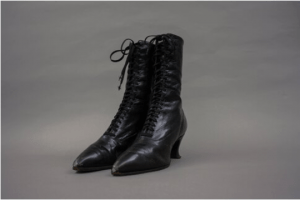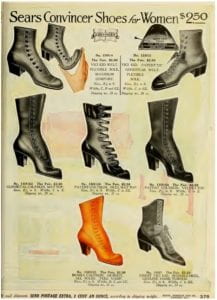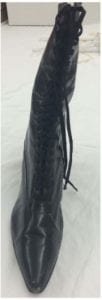Blog post by Jennifer Uber
This online blog post features materials protected by the Fair Use guidelines of Section 107 of the US Copyright Act. All rights reserved to the copyright owners.
While visiting the Cornell Fashion + Textile Collection, I was drawn to a particular style of women’s shoes featured in Figure 1.
These boots were manufactured by Marshall’s New York in the early 1900s during the Edwardian Era. They feature a thick 2-inch block heel, elongated pointed toe, mid-calf lace-up leather upper, and high curved arch. The primary effect of the boot was to provide stability to the ankle and protection during colder seasons. The donor of the boots is unknown, however, a lot can be inferred about the person based on the composition of the design and wear patterns.
I was originally attracted to the boots because of their uncomfortable-looking nature. The tight lacing, narrow foot, and high arch seemed extremely unappealing when compared to the comfortable designs of some modern shoes. However, upon further research, I discovered that this was a practical and common shoe for many middle to upper class women. Boot materials were of higher quality and embellishments were more extravagant for upper-class boots; however, the silhouette and shape remained the same across the varying price points (Vintage Dancer). Figure 2 shows various styles that emerged alongside the standard front-laced boots. Buttons replaced the laces and were positioned on the side of the shoe to create an asymmetric design. Some boots had straps or cutouts to allow colorful stockings to show through.
These boots proved to be perfect for daily errands and traveling. The thick block heel provided good stability while walking on uneven paths as roads and sidewalks were still being paved and the leather was extremely durable against nature’s elements. Leather on brand new shoes was extremely stiff, but as they were worn in the leather would become more flexible and molded. (Vintage Dancer). As seen in Figure 1, 3, and 4, overtime and multiple wears the leather would bend and crease to mold to the foot and the ankle.
Ideal Female Bodies
Women are constantly pressured to alter their bodies to conform to whatever the current standard of beauty might be. This was no different during the Edwardian Era when the exaggerated “s-curve” figure governed female body silhouettes. Women were to be slim yet curvy, which was only possible with a tight corset the snatched the waist and pushed the bust forward (Monet). What intrigued me was how the “s-curve” is also seen in the silhouette of the boots. In figure 3, we see a profile view of the boot that resembles the “s-curve”; the heel is reminiscent of a bustle while the ankle is similar to a corseted bodice.
Shoes during this era often played with form to create new foot shapes. According to NEH magazine, shoes “could be used to diminish the apparent size of the foot. Small feet, along with small hands, were one of the traditional attributes of a gentlewoman.” Slim feet were so prominent in America that Charles Dickens noticed that “the pinching of thin shoes” was a desirable part of American lady’s fashion during his trip in 1842. Keeping this fashion trend in mind, it becomes easier to understand the intent behind the design of the boots; the laces bind the ankle and foot to tighten their width, and the high arch and pointed toe elongate the foot to create a noticeable slimming effect.
High Heel History: Reinforcing Female Beauty Standards or Breaking Boundaries?
The history of the high heel is very significant as they were originally worn by men. Heels were first seen to demonstrate masculinity and power. According to curators at the Bata Shoe Museum, “When heels were first introduced into Western fashion around the turn of the 17th century, men eagerly embraced them and they continued wearing heels as expressions of power and prestige for over 130 years” Higher shoes signified superiority over a woman or lower class. During the 17th century, the “mannish women” style emerged, and some woman masculinized their attire and started wearing heels (VAM). This act of rebellion and self-expression was groundbreaking as it unintentionally opened the gates to heels made for women.
The second industrial revolution brought new technologies to the fashion industry allowing for a wide range of women’s heels to be produced and manufactured. As women’s heels quickly gained popularity, men’s heels started to disappear and so did their masculinity. One thing that remains the same between men’s and women’s heels is the symbol of power. The high heights of a heel suggest superiority over the ones below. Although modern heels have reached frightening heights, women feel empowered by their daring height. Unfortunately, it is rare for femininity to be associated with power, so it is odd that women’s high heels can remain powerful. Learning that women stole high heels from men to rebel against social norms makes the history of heels even more ironic. These boots allowed women greater opportunities in the outside world by providing them with protective foot wear for daily activities, travel, and exploration.
References
“1914 Sears Household Catalogue.” History on the Net, 1914, www.historyonthenet.com/authentichistory/1898-1913/3-consume-leisure/6-Consumerism/1914_Sears_Housewares/index.html.
Linder, Marc, and Charles L. Saltzman. “A HISTORY OF MEDICAL SCIENTISTS ON HIGH HEELS.” International Journal of Health Services, vol. 28, no. 2, Sage Publications, Inc., 1998, pp. 201–25, http://www.jstor.org/stable/45130648.
Rexford, Nancy. “Teensy-Weensy, Itty-Bitty Shoes.” The National Endowment for the Humanities, 2008, www.neh.gov/humanities/2008/marchapril/feature/teensy-weensy-itty-bitty-shoes.
Monet, Dolores. “Fashion History: Edwardian Style of the Late 1890s–1914.” Bellatory, 22 Mar. 2021, bellatory.com/fashion-industry/FashionHistoryEdwardianFashionTrends1890s1914.
“Standing TALL: The Curious History of Men in Heels.” Bata Shoe Museum, 2021, batashoemuseum.ca/online-exhibitions.
Vintage Dancer. “History of Victorian Boots & Shoes for Women.” Vintage Dancer, 4 Dec. 2012, vintagedancer.com/victorian/victorian-boots-shoes-history.
“History of Fashion 1840 – 1900 – Victoria and Albert Museum.” Victoria and Albert Museum, 2016, www.vam.ac.uk/content/articles/h/history-of-fashion-1840-1900.





